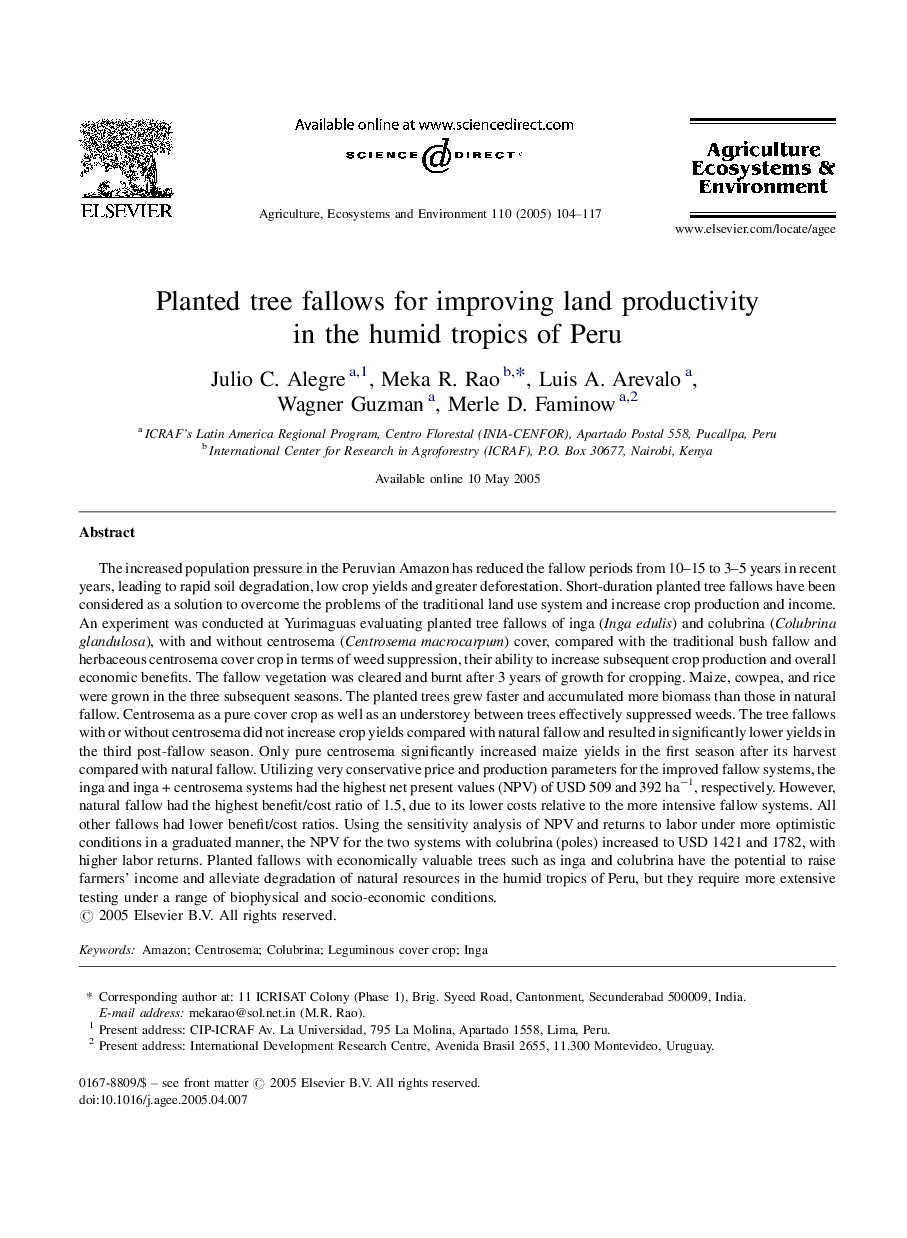| کد مقاله | کد نشریه | سال انتشار | مقاله انگلیسی | نسخه تمام متن |
|---|---|---|---|---|
| 8970774 | 1552154 | 2005 | 14 صفحه PDF | دانلود رایگان |
عنوان انگلیسی مقاله ISI
Planted tree fallows for improving land productivity in the humid tropics of Peru
دانلود مقاله + سفارش ترجمه
دانلود مقاله ISI انگلیسی
رایگان برای ایرانیان
کلمات کلیدی
موضوعات مرتبط
علوم زیستی و بیوفناوری
علوم کشاورزی و بیولوژیک
علوم زراعت و اصلاح نباتات
پیش نمایش صفحه اول مقاله

چکیده انگلیسی
The increased population pressure in the Peruvian Amazon has reduced the fallow periods from 10-15 to 3-5 years in recent years, leading to rapid soil degradation, low crop yields and greater deforestation. Short-duration planted tree fallows have been considered as a solution to overcome the problems of the traditional land use system and increase crop production and income. An experiment was conducted at Yurimaguas evaluating planted tree fallows of inga (Inga edulis) and colubrina (Colubrina glandulosa), with and without centrosema (Centrosema macrocarpum) cover, compared with the traditional bush fallow and herbaceous centrosema cover crop in terms of weed suppression, their ability to increase subsequent crop production and overall economic benefits. The fallow vegetation was cleared and burnt after 3 years of growth for cropping. Maize, cowpea, and rice were grown in the three subsequent seasons. The planted trees grew faster and accumulated more biomass than those in natural fallow. Centrosema as a pure cover crop as well as an understorey between trees effectively suppressed weeds. The tree fallows with or without centrosema did not increase crop yields compared with natural fallow and resulted in significantly lower yields in the third post-fallow season. Only pure centrosema significantly increased maize yields in the first season after its harvest compared with natural fallow. Utilizing very conservative price and production parameters for the improved fallow systems, the inga and inga + centrosema systems had the highest net present values (NPV) of USD 509 and 392 haâ1, respectively. However, natural fallow had the highest benefit/cost ratio of 1.5, due to its lower costs relative to the more intensive fallow systems. All other fallows had lower benefit/cost ratios. Using the sensitivity analysis of NPV and returns to labor under more optimistic conditions in a graduated manner, the NPV for the two systems with colubrina (poles) increased to USD 1421 and 1782, with higher labor returns. Planted fallows with economically valuable trees such as inga and colubrina have the potential to raise farmers' income and alleviate degradation of natural resources in the humid tropics of Peru, but they require more extensive testing under a range of biophysical and socio-economic conditions.
ناشر
Database: Elsevier - ScienceDirect (ساینس دایرکت)
Journal: Agriculture, Ecosystems & Environment - Volume 110, Issues 1â2, 1 October 2005, Pages 104-117
Journal: Agriculture, Ecosystems & Environment - Volume 110, Issues 1â2, 1 October 2005, Pages 104-117
نویسندگان
Julio C. Alegre, Meka R. Rao, Luis A. Arevalo, Wagner Guzman, Merle D. Faminow,